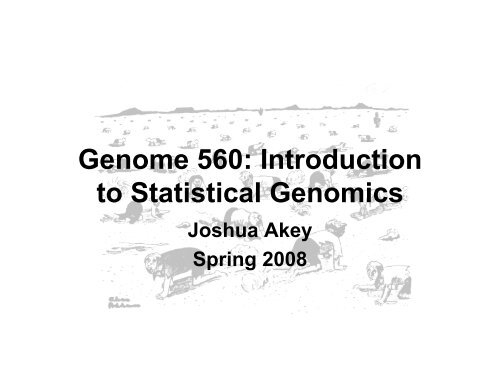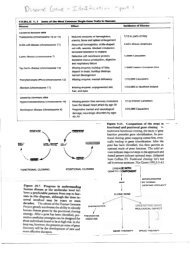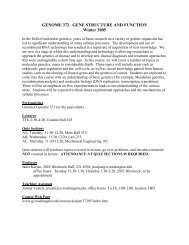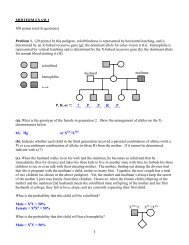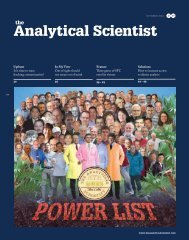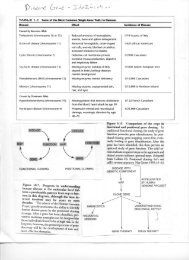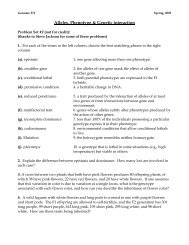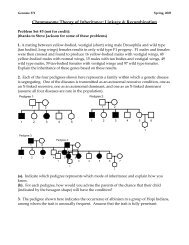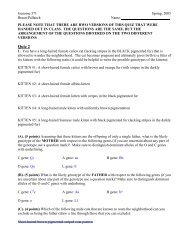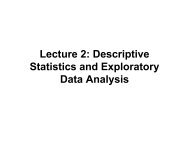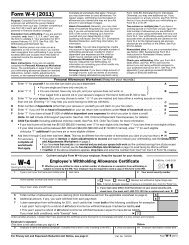Genome 560: Introduction to Statistical Genomics - Genome Sciences
Genome 560: Introduction to Statistical Genomics - Genome Sciences
Genome 560: Introduction to Statistical Genomics - Genome Sciences
Create successful ePaper yourself
Turn your PDF publications into a flip-book with our unique Google optimized e-Paper software.
<strong>Genome</strong> <strong>560</strong>: <strong>Introduction</strong><br />
<strong>to</strong> <strong>Statistical</strong> <strong>Genomics</strong><br />
Joshua Akey<br />
Spring 2008
Why You Are Taking This Course<br />
• It’s required - now shut up and sit down<br />
• Because I’m a sadist: You’re about <strong>to</strong> be<br />
confused, made <strong>to</strong> feel stupid, and bored for<br />
an entire quarter (shut up and sit down)
Why You Are Taking This Course<br />
• Data are interesting, and they are interesting because<br />
they help us understand the world<br />
• <strong>Genomics</strong> = Massive Amounts of Data Data<br />
• Statistics is fundamental in genomics because it is<br />
integral in the design, analysis, and interpretation<br />
of experiments
The Roots of Modern Statistics<br />
Emerged From Genetics
Sir Francis Gal<strong>to</strong>n<br />
Inven<strong>to</strong>r of fingerprints,<br />
study of heredity of quantitative traits<br />
Regression & correlation<br />
Also: efficacy of prayer,<br />
attractiveness as function of<br />
distance from London
Karl Pearson<br />
Polymath-<br />
Studied genetics<br />
Correlation coefficient<br />
χ 2 test<br />
Standard deviation
Sir Ronald Fisher<br />
The Genetical Theory of<br />
Natural Selection<br />
Founder of population genetics<br />
Analysis of variance<br />
likelihood<br />
P-value<br />
randomized experiments<br />
multiple regression<br />
etc., etc., etc.
Why I Am The Rightful Heir of <strong>Statistical</strong><br />
<strong>Genomics</strong><br />
Fisher<br />
Rao<br />
Chakraborty<br />
Jin<br />
Akey
“Central Dogma” of Statistics<br />
Population<br />
Probability<br />
Descriptive<br />
Statistics<br />
Sample<br />
Inferential Statistics
Course Stuff<br />
Syllabus:<br />
Date<br />
April 1<br />
April 3<br />
April 8<br />
April 10<br />
April 15<br />
April 17<br />
April 22<br />
April 24<br />
April 29<br />
May 1<br />
Topic<br />
Collecting Data and Experimental Design<br />
Descriptive Statistics and Visualizing Data<br />
Randomness and Probability<br />
Distributions<br />
Estimating Parameters<br />
Hypothesis testing 1: Inferences based on one or two samples<br />
Hypothesis testing 2: ANOVA<br />
Linear Regression<br />
Analysis of Categorical Data<br />
Assessing Significance in High-Dimensional Space<br />
Grading:<br />
5 problem sets (20% each) - sorry, really no other way
• No required text<br />
Books and Resources<br />
• Good on-line resources<br />
- http://www.math.wm.edu/~trosset/Courses/351/book.pdf<br />
- http://www.statsoft.com/textbook/stathome.html<br />
- http://www.stat.berkeley.edu/~stark/SticiGui/Text/<strong>to</strong>c.htm<br />
• Some good books if you ever have some extra $$$:<br />
- Probability and Statistics for Engineering and the <strong>Sciences</strong> 6th ed. Jay L. Devore.<br />
(2004). Duxbury press, Thompson-Brooks/Cole.<br />
- <strong>Statistical</strong> Inference. Casella, G. and Berger, R. L. (1990). Wadsworth, Belmont, CA.
Collecting Data and<br />
Experimental Design<br />
“[Experimental design] encompasses the myriad details that<br />
constitute the substance of the actual planning, conduct, and<br />
interpretation of a research study”<br />
- Ransohoff (2007) Journal of Clinical Epidemiology, 60:1205
Typical <strong>Genomics</strong> Data
Bad Things Can Happen With Bad<br />
Experimental Design
• Compared gene expression levels between 60 CEU and 82 ASN HapMap<br />
individuals<br />
• Tests of differential expression performed by parametric t-tests and adjustment<br />
for multiple testing through Sidak corrections<br />
• Estimate ~26% of genes <strong>to</strong> be differentially expressed
78% of Genes Are Estimated To Be<br />
Differentially Expressed
Population and Time of Processing<br />
Are Confounded<br />
Number of Arrays<br />
CEU<br />
ASN<br />
Jan Jan Jan Jan Jan<br />
2002 2003 2004 2005 2006<br />
Date
Batch Effects Can Completely<br />
Account For Differential Expression<br />
Between<br />
Population<br />
Between<br />
Years<br />
Between Populations,<br />
Adjusting For Years<br />
78% of genes estimated<br />
<strong>to</strong> be differentially<br />
96% of genes estimated<br />
<strong>to</strong> be differentially<br />
0% of genes estimated <strong>to</strong><br />
be differentially
Elements of Good Experimental Design<br />
• Experimental design is a whole sub-discipline in statistics research<br />
• For genetics/genomics studies the two most important ideas are:<br />
1. Randomization<br />
2. Control<br />
• Randomization and control are essential for making valid statistical<br />
inferences and minimizing bias caused by confounding variables
Some Jargon<br />
• Units: the basic objects on which the experiment is done<br />
• Variable: a measured characteristic of a unit<br />
• Treatment: any specific experimental condition applied <strong>to</strong> the<br />
units. A treatment can be a combination of specific values (called<br />
levels) of each experimental fac<strong>to</strong>r.<br />
• Bias: consistent divergence between the value of a variable in a<br />
sample from the corresponding value in a population
Why Randomize<br />
• Breaks the association between potential confounding<br />
variables and the explana<strong>to</strong>ry variables<br />
• Confounding variables: variables whose effects cannot be<br />
distinguished from one another<br />
• Helps <strong>to</strong> avoid hidden sources of bias:<br />
- Association of shoe size (S) and literacy (L) in kids<br />
S L S L<br />
A
Randomization<br />
• Randomization can be implemented in multiple ways<br />
depending on the particular experiment<br />
– Randomly selecting individuals from a population<br />
– Randomly assigning treatments <strong>to</strong> units in an experiment<br />
– Randomization in the technical aspects of how an experiment<br />
is performed
Experimental units<br />
Confounding<br />
Treatments<br />
Confounding variable<br />
Without<br />
randomization,<br />
the confounding<br />
variable differs<br />
among<br />
treatments
Experimental units<br />
Confounding<br />
Treatments<br />
Confounding variable<br />
With<br />
randomization,<br />
the confounding<br />
variable does not<br />
differ among<br />
treatments
Other Aspects of Good Experimental Design<br />
• Balanced experimental design: all treatments have equal<br />
sample size<br />
Better than<br />
Balanced<br />
Unbalanced<br />
• Replication: reduces and allows estimates of variation<br />
– Technical versus Biological
Eliminating Bias: Controls<br />
• A control group is a group of subjects left<br />
untreated for the treatment of interest but<br />
otherwise experiencing the same conditions<br />
as the treated subjects<br />
• Example: one group of patients is given an<br />
inert placebo
Thought Question<br />
Using the principles we just discussed, how<br />
would you design the gene expression<br />
study of Cheung et al. discussed<br />
previously?
Summary: Elements of Good<br />
Experimental Design<br />
• Allow unbiased estimation of treatment effects<br />
• Allow estimation of underlying variability<br />
• Control for known sources of extraneous variation<br />
• Allocate treatments <strong>to</strong> units randomly<br />
• As simple as possible
What is R?<br />
• The R statistical programming language is a free open source<br />
package based on the S language developed by Bell Labs<br />
• Many statistical functions are already built in<br />
• Contributed packages expand the functionality <strong>to</strong> cutting edge<br />
research<br />
• Amazing graphics<br />
• Widely used in genetics, genomics, bioinformatics: Learn it, love<br />
it, use it…
R Resources<br />
• Windows, Mac, and Linux binaries available at:<br />
http://www.r-project.org<br />
• Extensive resources at the above web-site, in<br />
particular see:<br />
http://cran.r-project.org/other-docs.html
Goals of Our R Tu<strong>to</strong>rial<br />
• Installing R<br />
• Using R as a fancy calcula<strong>to</strong>r<br />
• Data structures: scalars, vec<strong>to</strong>rs, data frames, matrices<br />
• Reading in data from a file<br />
• Subsetting and extracting data<br />
• Writing and executing simple R scripts


